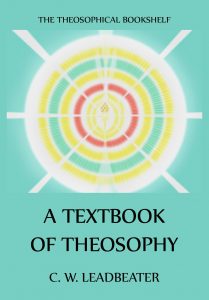A Textbook Of Theosophy – C. W. Leadbeater
Theosophy is not only a basis of religion; it is also a philosophy of life. As such, its main teachings are reincarnation and the law of Karma. Karma is the outcome of the collective life, a law of ethical causation. In the past incarnation the ego had acquired certain faculties, set in motion certain causes. The effect of these causes and of causes set in motion in previous incarnations and not yet exhausted are its Karma and determine the conditions into which the ego is reborn. Thus inequalities of natural gifts, e.g. genius, of temperament and of character are explained. The law of progress is the law of involution and evolution, the returning of the Divine Spark into a unity with Spirit through various reincarnations, which are viewed as a process of purification. Sin, poverty, and misery are the fruits of ignorance, and are gradually removed as the spirit in us becomes freed from earthly dross. There is no heaven nor Hell. Death is the passage from this state of life to another. There is an evolution behind and before, with absolute certainty of final attainment for every human soul, i.e. to be one with the Absolute. As man advances in this process his spirit becomes stronger, and can develop latent powers, not shown in ordinary mortals. This textbook is your portal to a new sight of life and religion.

A Textbook Of Theosophy
Format: Paperback.
A Textbook Of Theosophy.
ISBN: 9783849675127.
Available at amazon.com and other venues.
Common characteristic of theosophy (from wikipedia.com)
Theosophy actually designates a specific flow of thought or tradition within the modern study of esotericism. Thus, it follows the path starting from the more modern period of the 15th century onward. Faivre describes the “theosophic current” or theosophy as a single esoteric current among seven other esoteric currents in early modern Western thought (i.e., alchemy, astrology, Neo-Alexandrian Hermeticism, Christian Kabbalah, Paracelsism (i.e., the studying of the “prognostications” of Paracelsus), philosophia occulta and Rosicrucianism). Christian theosophy is an under-researched area; a general history of it has never been written.
Faivre noted that there are “obvious similarities” between earlier theosophy and modern Theosophy as both play an important part in Western esotericism and both claim to deal with wisdom from a gnostic perspective. But he says there are also differences, since they do not actually rely on the same reference works; and their style is different. The referential corpus of earlier theosophy “belongs essentially to the Judeo-Christian type”, while that of modern Theosophy “reveals a more universal aspect”. Although there are many differences between Christian theosophy and the Theosophical movement begun by Helena Blavatsky, the differences “are not important enough to cause an insurmountable barrier.” When referring to the ideas related to Blavatsky and the Theosophical Society, the word “Theosophy” is capitalized; otherwise it is not. Theosophy and theosophists refer to Blavatsky’s philosophy while theosophy and theosophers refer to Christian theosophy. Some Theosophists were also theosophers. Blavatsky linked her use of the word theosophy to the Neoplatonists and Ammonius Saccas, rather than to the later Christian theosophers.
Theosophers engage in analysis of the universe, humanity, divinity, and the reciprocal effects of each on the other. The starting point for theosophers may be knowledge of external things in the world or inner experiences and the aim of the theosopher is to discover deeper meanings in the natural or divine realm. Antoine Faivre notes, “the theosophist dedicates his energy to inventing (in the word’s original sense of ‘discovering’) the articulation of all things visible and invisible, by examining both divinity and nature in the smallest detail.” The knowledge that is acquired through meditation is believed to change the being of the meditator.
Faivre identified three characteristics of theosophy. The three characteristics of theosophy are listed below.
Theosophy:
Divine/Human/Nature Triangle: The inspired analysis which circles through these three angles. The intradivine within; the origin, death and placement of the human relating to Divinity and Nature; Nature as alive, the external, intellectual and material. All three complex correlations synthesize via the intellect and imaginative processes of Mind.
Primacy of the Mythic: The creative Imagination, an external world of symbols, glyphs, myths, synchronicities and the myriad, along with image, all as a universal reality for the interplay conjoined by creative mind.
Access to Supreme Worlds: The awakening within, inherently possessing the faculty to directly connect to the Divine world(s). The existence of a special human ability to create this connection. The ability to connect and explore all levels of reality; co-penetrate the human with the divine; to bond to all reality and experience a unique inner awakening.
(The text of the last section was taken from a Wikipedia entry and is available under the the Creative Commons Attribution-ShareAlike License.)
Publisher’s Note: This book is printed and distributed by Createspace a DBA of On-Demand Publishing LLC and is typically not available anywhere else than in stores owned and operated by Amazon or Createspace.
